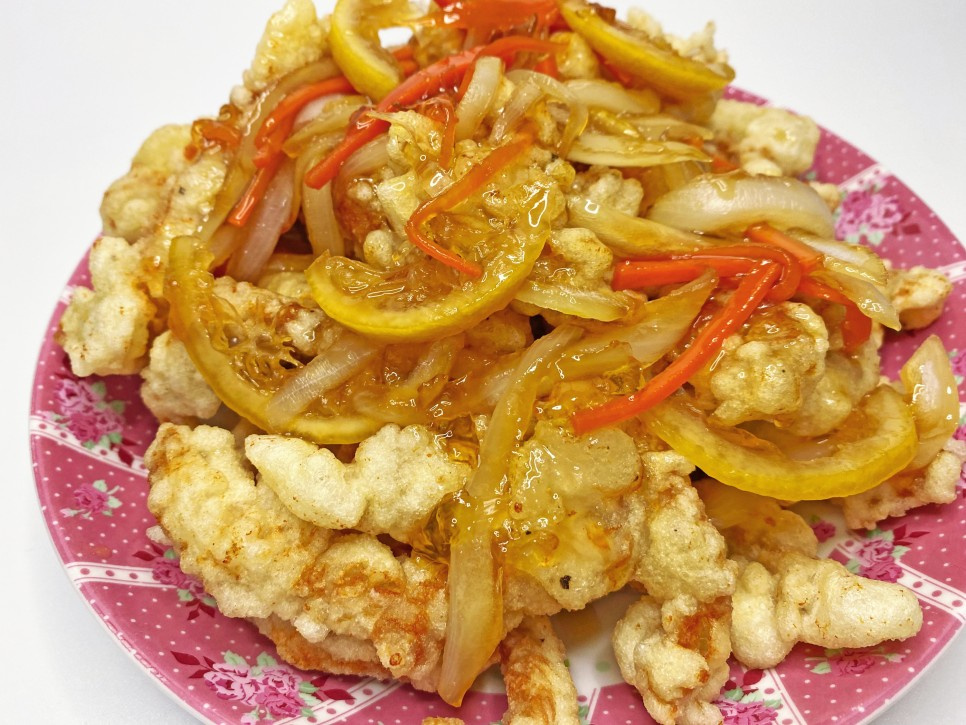Chewy Sweet Rice Tangsuyuk (Sweet and Sour Pork)
Making Crispy and Chewy Sweet Rice Tangsuyuk with a Kkwobaegi Texture at Home

This is a recipe for chewy sweet rice tangsuyuk! The freshly fried pork is incredibly delicious, with a crispy exterior and a moist, tender inside. It pairs perfectly with the sweet and sour sauce, making for a delightful meal. We’ll share the secrets to making the perfect tangsuyuk batter and its accompanying sauce. This recipe yields 2-3 servings.
Sweet Rice Tangsuyuk Ingredients- 400g Pork loin or tenderloin (cut into wide, flat pieces)
- 350g Potato starch
- 200g Water
- 25g Egg wash (about 1/2 egg)
- 2 tsp Salt
- Pinch of black pepper
- Vegetable oil for deep-frying (generous amount)
Sweet and Sour Tangsuyuk Sauce Ingredients- 2 Tbsp Soy sauce
- 8 Tbsp Sugar
- 8 Tbsp Vinegar
- 8 Tbsp Water
- 2 Tbsp Lemon preserves (or 1.5 Tbsp lemon juice)
- 18g Carrot (finely julienned)
- 1/4 Onion (finely julienned)
- Starch slurry (1 Tbsp starch + 1 Tbsp water)
- 2 Tbsp Soy sauce
- 8 Tbsp Sugar
- 8 Tbsp Vinegar
- 8 Tbsp Water
- 2 Tbsp Lemon preserves (or 1.5 Tbsp lemon juice)
- 18g Carrot (finely julienned)
- 1/4 Onion (finely julienned)
- Starch slurry (1 Tbsp starch + 1 Tbsp water)
Cooking Instructions
Step 1
Let’s start making delicious sweet rice tangsuyuk! Prepare 400g of pork loin or tenderloin, cut into wide and flat pieces, perfect for tangsuyuk. Slicing them thinly and broadly will give you a texture similar to Kkwobaegi.

Step 2
Season the prepared pork with 2 tsp of salt and a pinch of black pepper. Gently massage the seasoning into the meat with your hands. Let it rest for a bit to tenderize the pork.

Step 3
While the pork marinates, prepare the vegetables for the sauce. Wash the onion and carrot and julienne them finely. If using lemon preserves, take out about 3-4 slices of lemon and cut them in half.

Step 4
In a large bowl, combine 350g of potato starch with 200g of water. Mix thoroughly until smooth to create the starch batter. Ensure there are no lumps.

Step 5
Lightly beat one egg. Add approximately 25g of this egg wash (about half of the beaten egg) to the starch batter. Adding too much egg wash can make the coating too hard, so using just the specified amount is key.

Step 6
Mix the egg wash into the starch batter until well combined. Your tangsuyuk batter is now ready! The ideal consistency is when the batter flows smoothly like thick syrup. If it’s too thick, the coating will be heavy; if it’s too thin, it won’t adhere well to the pork. Check the consistency carefully.

Step 7
Add the marinated pork pieces to the prepared batter. Gently toss and mix to ensure each piece of pork is evenly coated with the batter.

Step 8
Heat a generous amount of vegetable oil in a deep wok or pot to 180°C (350°F). If the oil is too hot, the coating will burn before the pork is cooked. If it’s too cool, the pork will absorb too much oil and become soggy. Use a thermometer or test with a wooden chopstick to check for steady bubbles. Avoid overcrowding the wok; fry the pork in batches to maintain the oil temperature.

Step 9
Carefully place the battered pork pieces into the 180°C oil and deep-fry for about 3-4 minutes, until lightly golden. Remove the fried pork and drain excess oil on a wire rack. For that signature crispy and chewy texture, a double-fry method is essential. Once all the pork is fried the first time, reheat the oil to 180°C for the second fry.

Step 10
Return the partially fried tangsuyuk to the 180°C oil and fry for another 1-2 minutes. This second fry will give the tangsuyuk a deep golden brown color and ensure maximum crispiness.

Step 11
The tangsuyuk on the left has been double-fried, while the one on the right was only fried once. You can clearly see the difference in color; the double-fried version is a richer golden brown and looks much more appealing and appetizing.

Step 12
After the second fry, place the crispy tangsuyuk back on the wire rack to drain any remaining oil. Letting it rest briefly helps achieve a cleaner finish.

Step 13
Now, let’s make the delicious sauce! In a preheated pan, combine 8 Tbsp water, 2 Tbsp soy sauce, 8 Tbsp sugar, 8 Tbsp vinegar, and 2 Tbsp lemon preserves. Bring this mixture to a simmer over medium heat. Once boiling, add the julienned onion, carrot, and halved lemon slices.

Step 14
When the vegetables become slightly translucent and the sauce begins to thicken, it’s time to add the starch slurry. Prepare the slurry by mixing 1 Tbsp starch with 1 Tbsp water until smooth. Gradually pour the slurry into the simmering sauce while stirring to achieve the desired consistency.

Step 15
The sauce will thicken almost immediately upon adding the slurry. Continue stirring and cooking for another 10-20 seconds until the sauce reaches your preferred thickness. Be careful not to overcook, as it can become too salty. Your sweet and sour tangsuyuk sauce is ready!

Step 16
Arrange the fried tangsuyuk pieces on a serving plate. Pour the warm sauce generously over the top for a ‘sauce-drenched’ (Bumuk) style. If you prefer to dip your pork in the sauce separately (‘Jjikmeok’ style), simply serve the sauce in a small bowl on the side. Enjoy your homemade sweet rice tangsuyuk!



